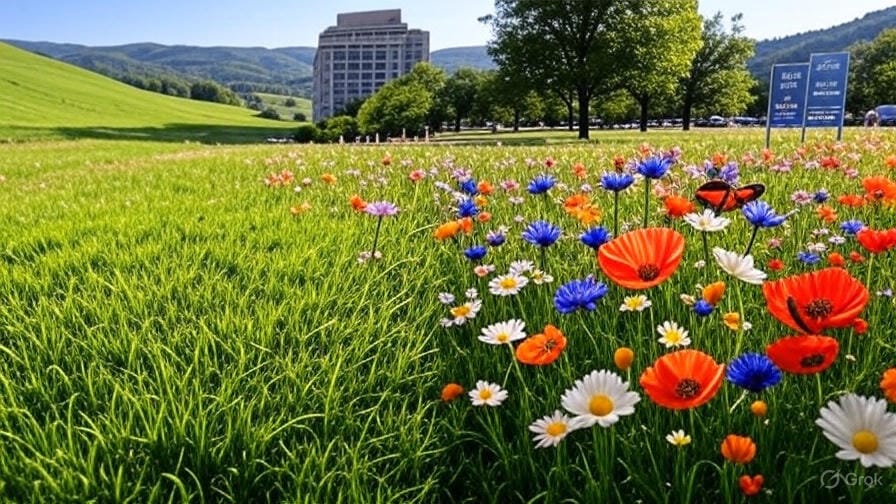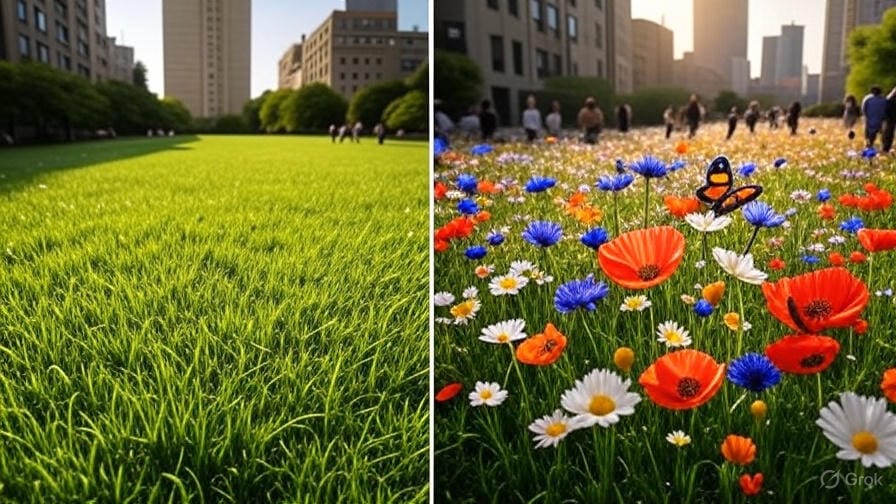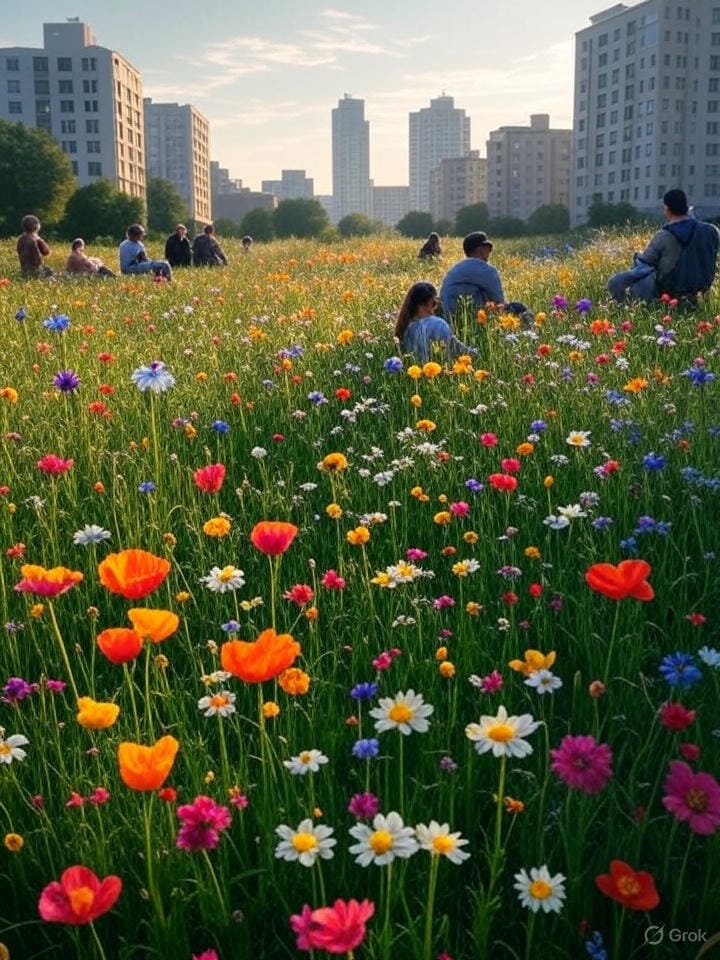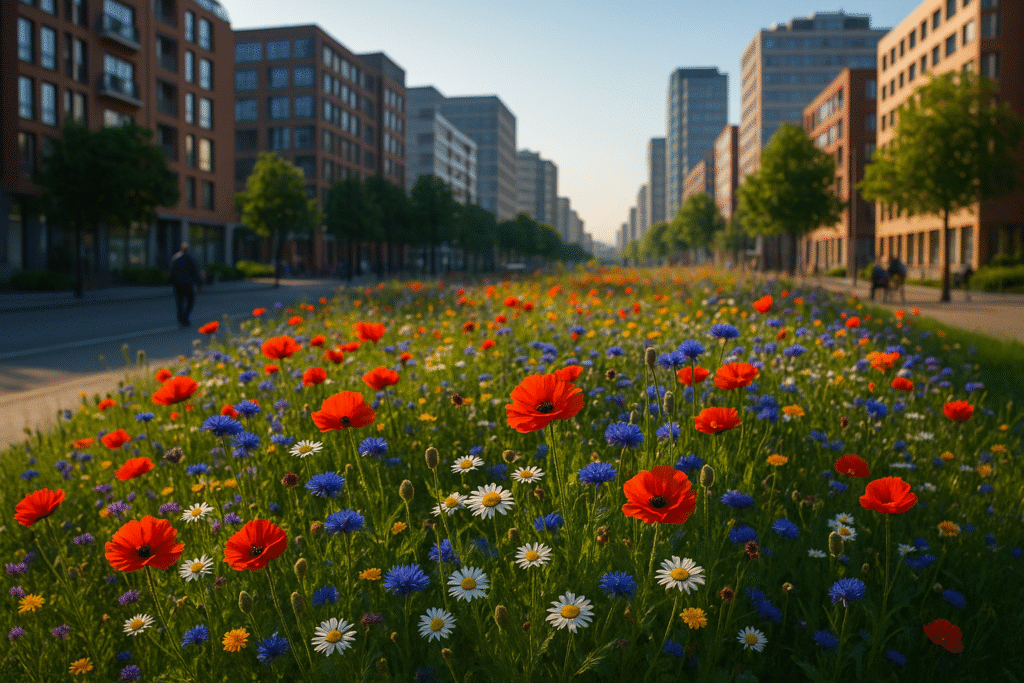
Table of Contents
ToggleWhat is the Importance of Urban wildflower meadow biodiversity
Almost every cityrisilled with concrete, noise and monotony and now a quiet revolution is taking root. Urban wildflower meadow biodiversity has become more than just an aesthetic experiment. For decades city parks, medians and roadside verges were covered with turfgrass that is neat, sterile and green. But beneath that surface, lies a biological desert. Wild pollinators vanish and birds go silent
Urban wildflower meadows flip this script. They reintroduced native plants, attracting bees, birds and butterflies. This all creates micro ecosystems where nearly everything can flourish again. From London’s Queen Elizabeth Olympic Park to pockets in Berlin, Toronto and Melbourne cities are replacing manicured lawns with rich and layered meadows.
You will see more colour ,hear more buzzing and feel more alive in such spaces. But that’s not all, you are also standing on soil being quietly restored, watching food webs reconnected and witnessing a biodiversity comeback. In this blog ahead we will explore why urban wildflower meadow biodiversity matters and what it really takes to create one with hidden challenges that cities might face.
What are the benefits of wildflower meadows in cities
At first sight, wildflower meadows might seem like just a pretty patch of nature that is tucked between buildings. But the benefits of wildflower meadows are way deeper. Check out constructed Wetlands
1. They rescue Urban pollinators
Bees, butterflies and hoverflies are in sharp decline globally due to habitat loss. Cities that are dominated by payment and monoculture lawns offer little food or shelter. But wildflower meadows change that instantly. They provide a buffer of nectar rich native plants across seasons that attract pollinators to return. In fact meadows can support 10x more pollinators than traditional lawns.
2. They rebuild soil and reduce Maintenance
Beneath the surface, wildflower roots loosen compacted soil, support mycorrhizal fungi and boost carbon Sequestration. Over time this transforms lifeless dirt into a living sponge. And unlike mowed grass, wildflower meadows don’t need weekly cutting, fertilizers or irrigation which makes them a long-term, low-cost investment.
3. They create biodiversity Hotspots
Urban wildflower meadows become magnets for insects, birds, amphibians and even small mammals. A single meadow patch can support dozens of interlinked species which helps to restore lost food webs right in the city center. That’s why ecologists call them “micro reserves of life”
4. They cool down the Urban Heat Island effect
Concrete-heavy cities absorb and radiate heat especially in summer. Wildflower meadows, with their tall and layered vegetation help to lower the surface temperature through shade and evaporation. This natural cooling effect can reduce surrounding air temperature by 2-4 °C especially when planted in clusters.
5. They transform grey spaces into sanctuaries
Beyond science, there is a Deeper human benefit. Wildflower meadows bring an emotional lift to Urban environments. Their changing colours, buzzing sounds and gentle movement offer relief from the hard and angular stress of city life. Residents living near urban meadows report lower anxiety and more daily happiness.
6. They make Vacant land useful again
Cities are full of forgotten spaces like roadside verges, empty plots and awkward corners near transit lines. Wildflower meadows can reclaim these ignored pockets to make them into living and self-sustaining green infrastructure that costs little but gives back daily.

Challenges of urban Wildflower meadow biodiversity
For all their ecological and aesthetic value wild flower meadows in cities still remain rare. Let’s take a look at what’s stopping cities from planting more wildflower meadows. A similar topic – Multi-layer forest miyawaki method
1. City spaces are designed for grass
Most urban landscapes are planted with flat and sterile turf in mind. Lowers, sprinklers and budgets all follow this model. Transforming this into wild flower meadows often means retraining maintenance crews, changing contracts and rethinking the aesthetic expectations of neat and tidy green spaces. Cities like Utrecht and Sheffield now include meadow design in urban planning from the start and treat them as permanent features.
2. Poor soil conditions
Urban soils are often compacted and low in nutrition or contaminated, none of which supports thriving wildflowers. Seed mixes that work in rural parks may fail in inner city soils unless the ground is prepped right. Smart cities are now using soil amenders, low nutrient substrates or even green roof style engineered Soil that blends to stimulate natural meadow conditions.
3. Importance of Public Perception
Some residents complain that meadows look abandoned or Messy when they go dormant especially in high-traffic or wealthier districts. This can lead to mowing them down before they become mature. Show the solution is intentional farming. Add Mown borders, signage that educates or even art installations. Meadows with sharp edges and signs are 50% more accepted by the people.
4. Fear pests and allergies
People often worry that meadows will bring rodents, snakes or allergenic plants. These concerns which are often unfounded but still influence the city council’s decisions. So use customised native seed Mixes that exclude allergy-inducing species and conduct pre-installation public outreach. Some cities even host “meadow days” where residents see the pollinators firsthand which shifts their perceptions from fear to fascination.
5. Upfront costs and delayed results
Making a meadow and preparing the soil is costly. And the visual rewards don’t come instantly, it might take one or two full growing seasons before meadow peaks. Some municipalities offset costs by partnering with schools, NGOs or pollinator programs. And by choosing fast-germinating annual natives in the first year, cities can give residents an early win.
6. Lack of Local Expertise or contractors
Unlike lawn mowing or tree planting, wildflower meadow design needs ecological insight and long-term vision. Many cities simply lack experienced designers or seed suppliers familiar with urban-scale meadows. As a solution cities like Berlin and Toronto are developing publicly funded meadow guidelines and even training contractors in meadow installation techniques.

Urban Meadow Design Guidelines
Choose Native wildflowers that suit the local microclimate: you don’t have to go just for colour, but you have to go for compatibility. Pick wildflower species that are native not just to your region but specifically suited for urban microclimates. Native species are sure to have higher pollinator activity and better survival rates without frequent watering. The mistry, Sponge City
Mix Heights and bloom Times for visual and ecological diversity: structure matters. Use a mix of short, medium and tall wildflowers to provide vertical diversity for insects and birds. Also, stagger bloom periods across the seasons (spring to late autumn) so there’s always a nectar source available. This supports pollinators over a longer stretch of the year.
Include native grasses for soil stability: urban wild flower meadows often fail because they lack proper structure. Add native bunch grasses like Festuca Rubra or Deschampsia cespitosa to hold soil. Suppress weeds and give the meadow a cohesive + managed look. Research from the UK’s Forest Research highlights that well-designed green infrastructure, such as soil formation, habitat support, stormwater management, and climate regulation.
Plan for Access paths: even the wildest urban meadow benefits from a frame. Mowed borders or walking paths can make your meadow appear un-negligible. They also offer easy maintenance access and give the public a way to engage without trampling biodiversity.
Choose sites with good sunlight: avoid shaded and heavily compacted areas with high traffic. Ideal sites get at least 6 hours of sunlight and have some soil depth (even on green roofs). They should not be at risk of being walked over, Even small roadside verges or roundabouts can work if protected.
According to EPA, green infrastructure can reduce urban heat, support habitat connectivity and improve air quality.

Urban wildflower meadow biodiversity case studies
Here are a few examples from across the world where cities are experimenting with urban wildflower meadow biodiversity.
London’s Olympics park meadows
This meadow is located in Queen Elizabeth Olympic Park. It is designed by ecologist James Hitchmough using designed plant communities. It featured over 150 native and naturalised species. It became an iconic model for pollinator-friendly design in urban public Parks. It has increased sightings of rare bees, hoverflies and even small mammals.
New york City’s Urban meadow
It is located in Randall’s Island and various road medians. The NYC Parks Department replaced turf grass with low-maintenance meadows. It includes pollinator mixes with native plants- goldenrod, coneflowers and milkweed. Mowed only once or twice a year. Due to NYC meadow pollinator counts Rose significantly and Monarch butterflies returned to milkweed stands.
Munich’s Tramway Meadows
It is located between tram tracks throughout the city. Narrow wildflower strips are planted along prime lines which is ideal for tight spaces. Designers have chosen low-growing native species to maintain driver visibility. It can absorb stormwater, reduce urban heat and add color to the city’s gray zones. It has led to a 30% increase in urban insect diversity within 3 years.
FAQs
Will an urban wildflower meadow look messy or neglected ?
No, if designed properly. By using defined edges, low-growing native species and educational signage you can make the space look intentional not abandoned. Many cities now use Mown borders or paths to frame the meadows.
Do wildflower meadows require maintenance ?
Not entirely. Meadows require lower maintenance than lawns yet they still need periodic care like annual mowing, weeding in the 1st year and sometimes re-seeding. The key is smart design that reduces long-term intervention.
Can urban meadows really make a difference for Biodiversity?
Absolutely yes. Even small plots attract pollinators, insects, birds and small mammals. In fragmented urban landscapes every patch matters and meadows create valuable stepping stones that reconnect the ecosystem.
